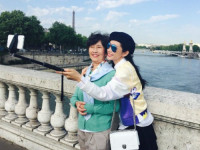系统标签控制器的使用——UITabBarController
来源:互联网 发布:淘宝怎么开店流程 编辑:程序博客网 时间:2024/05/23 13:12
创建一个TabBarController:
UITabBarController * tabBar= [[UITabBarController alloc]init];
NSMutableArray *controllerArray = [[NSMutableArray alloc]init];
for (int i=0; i<4; i++) {
UIViewController * con =[[UIViewController alloc]init];
[con loadViewIfNeeded];
con.view.backgroundColor= [UIColor colorWithRed:arc4random()%255/255.0 green:arc4random()%255/255.0blue:arc4random()%255/255.0 alpha:1];
con.tabBarItem.image =[UIImage imageNamed:@"btn_publish_face_a.png"];
con.tabBarItem.title=[NSString stringWithFormat:@"%d",i+1];
con.title = [NSStringstringWithFormat:@"%d",i+1];
[controllerArrayaddObject:con];

通过点击下面的标签按钮,可以很方便的切换控制器。如果我们的控制器数超过4个,系统会被我们创建一个more的导航,并且可以通过系统自带的编辑来调整控制器的顺序,如下:
二、UITabBarController的属性和方法
//管理的viewController数组@property(nullable, nonatomic,copy) NSArray<__kindof UIViewController *> *viewControllers;
- (void)setViewControllers:(NSArray<__kindof UIViewController *> * __nullable)viewControllers animated:(BOOL)animated;
//选中的ViewControlle@property(nullable, nonatomic, assign) __kindof UIViewController *selectedViewController;
//通过编号设置选中ViewController@property(nonatomic) NSUInteger selectedIndex;
//当viewController大于4个时,获取"更多"标签的导航控制器@property(nonatomic, readonly) UINavigationController *moreNavigationController;
//这个属性设置的是可以进行自定义排列顺序的视图控制器,如上面第二张图中的,默认是全部@property(nullable, nonatomic, copy) NSArray<__kindof UIViewController *> *customizableViewControllers;
//标签控制器中分装的标签栏@property(nonatomic,readonly) UITabBar *tabBar NS_AVAILABLE_IOS(3_0);
//代理@property(nullable, nonatomic,weak) id<UITabBarControllerDelegate> delegate;
三、关于标签栏TabBar属性
1、UITabBar属性和方法
设置标签:
@property(nullable,nonatomic,copy) NSArray<UITabBarItem *> *items; //设置选中的标签 @property(nullable,nonatomic,assign) UITabBarItem *selectedItem; - (void)setItems:(nullable NSArray<UITabBarItem *> *)items animated:(BOOL)animated;设置自定义标签顺序:
//调用这个方法会弹出一个类似上面第二张截图的控制器,我们可以交换标签的布局顺序- (void)beginCustomizingItems:(NSArray<UITabBarItem *> *)items; //完成标签布局- (BOOL)endCustomizingAnimated:(BOOL)animated; //是否正在自定义标签布局- (BOOL)isCustomizing;设置tabBar颜色相关:
//设置渲染颜色,会影响选中字体和图案的渲染@property(null_resettable, nonatomic,strong) UIColor *tintColor;//设置导航栏的颜色@property(nullable, nonatomic,strong) UIColor *barTintColor;设置背景图案:
//设置导航栏背景图案@property(nullable, nonatomic,strong) UIImage *backgroundImage;//设置选中一个标签时,标签背后的选中提示图案 这个会出现在设置的item图案的后面@property(nullable, nonatomic,strong) UIImage *selectionIndicatorImage;//设置阴影的背景图案@property(nullable, nonatomic,strong) UIImage *shadowImageTabBar中标签的宏观属性:
//设置标签item的位置模式@property(nonatomic) UITabBarItemPositioning itemPositioning;//枚举如下typedef NS_ENUM(NSInteger, UITabBarItemPositioning) { UITabBarItemPositioningAutomatic,//自动 UITabBarItemPositioningFill,//充满 UITabBarItemPositioningCentered,//中心} NS_ENUM_AVAILABLE_IOS(7_0);//设置item宽度@property(nonatomic) CGFloat itemWidth;//设置item间距@property(nonatomic) CGFloat itemSpacing;与导航栏类似,也可以设置tabBar的风格和透明效果:
//风格 分黑白两种@property(nonatomic) UIBarStyle barStyle;//是否透明效果@property(nonatomic,getter=isTranslucent) BOOL translucent;2、UITabBarDelegate
//选中标签时调用
- (void)tabBar:(UITabBar *)tabBar didSelectItem:(UITabBarItem *)item;
//将要开始编辑标签时
- (void)tabBar:(UITabBar *)tabBar willBeginCustomizingItems:(NSArray<UITabBarItem *> *)items; //已经开始编辑标签时
- (void)tabBar:(UITabBar *)tabBar didBeginCustomizingItems:(NSArray<UITabBarItem *> *)items;
//将要进入编辑状态时
- (void)tabBar:(UITabBar *)tabBar willEndCustomizingItems(NSArray<UITabBarItem *> *)items changed:(BOOL)changed;
//已经进入编辑状态时
- (void)tabBar:(UITabBar *)tabBar didEndCustomizingItems(NSArray<UITabBarItem *> *)items changed:(BOOL)changed;
四、再看UITabBarItem
//通过标题和图案进行创建
- (instancetype)initWithTitle:(nullable NSString *)title image:(nullable UIImage *)image tag:(NSInteger)tag;
- (instancetype)initWithTitle:(nullable NSString *)title image:(nullable UIImage *)image selectedImage:(nullable UIImage *)selectedImage;
//创建系统类型的
- (instancetype)initWithTabBarSystemItem:(UITabBarSystemItem)systemItem tag:(NSInteger)tag;
UITabBarSystemItem的枚举如下:
typedef NS_ENUM(NSInteger, UITabBarSystemItem) { UITabBarSystemItemMore,//更多图标 UITabBarSystemItemFavorites,//最爱图标 UITabBarSystemItemFeatured,//特征图标 UITabBarSystemItemTopRated,//高级图标 UITabBarSystemItemRecents,//最近图标 UITabBarSystemItemContacts,//联系人图标 UITabBarSystemItemHistory,//历史图标 UITabBarSystemItemBookmarks,//图书图标 UITabBarSystemItemSearch,//查找图标 UITabBarSystemItemDownloads,//下载图标 UITabBarSystemItemMostRecent,//记录图标 UITabBarSystemItemMostViewed,//全部查看图标};UITabBarItem常用属性:
//设置选中图案@property(nullable, nonatomic,strong) UIImage *selectedImage;下面这个属性可以设置item的头标文字:
con.tabBarItem.badgeValue = @"1";
//设置标题的位置偏移@property (nonatomic, readwrite, assign) UIOffset titlePositionAdjustment;
//标题
@property(nullable, nonatomic,copy) NSString *title;
//图案
@property(nullable, nonatomic,strong) UIImage *image;
//横屏时的图案
@property(nullable, nonatomic,strong) UIImage *landscapeImagePhone;
//图案位置偏移
@property(nonatomic) UIEdgeInsets imageInsets;
//横屏时的图案位置偏移
@property(nonatomic) UIEdgeInsets landscapeImagePhoneInsets ;
//设置和获取标题的字体属性
- (void)setTitleTextAttributes:(nullable NSDictionary<NSString *,id> *)attributes forState:(UIControlState)state; - (nullable NSDictionary<NSString *,id> *)titleTextAttributesForState:(UIControlState)state;
//选中标签时调用
- (void)tabBar:(UITabBar *)tabBar didSelectItem:(UITabBarItem *)item;
//将要开始编辑标签时
- (void)tabBar:(UITabBar *)tabBar willBeginCustomizingItems:(NSArray<UITabBarItem *> *)items; //已经开始编辑标签时
- (void)tabBar:(UITabBar *)tabBar didBeginCustomizingItems:(NSArray<UITabBarItem *> *)items;
//将要进入编辑状态时
- (void)tabBar:(UITabBar *)tabBar willEndCustomizingItems(NSArray<UITabBarItem *> *)items changed:(BOOL)changed;
//已经进入编辑状态时
- (void)tabBar:(UITabBar *)tabBar didEndCustomizingItems(NSArray<UITabBarItem *> *)items changed:(BOOL)changed;
四、再看UITabBarItem
//通过标题和图案进行创建
- (instancetype)initWithTitle:(nullable NSString *)title image:(nullable UIImage *)image tag:(NSInteger)tag;
- (instancetype)initWithTitle:(nullable NSString *)title image:(nullable UIImage *)image selectedImage:(nullable UIImage *)selectedImage;
//创建系统类型的
- (instancetype)initWithTabBarSystemItem:(UITabBarSystemItem)systemItem tag:(NSInteger)tag;
UITabBarSystemItem的枚举如下:
typedef NS_ENUM(NSInteger, UITabBarSystemItem) { UITabBarSystemItemMore,//更多图标 UITabBarSystemItemFavorites,//最爱图标 UITabBarSystemItemFeatured,//特征图标 UITabBarSystemItemTopRated,//高级图标 UITabBarSystemItemRecents,//最近图标 UITabBarSystemItemContacts,//联系人图标 UITabBarSystemItemHistory,//历史图标 UITabBarSystemItemBookmarks,//图书图标 UITabBarSystemItemSearch,//查找图标 UITabBarSystemItemDownloads,//下载图标 UITabBarSystemItemMostRecent,//记录图标 UITabBarSystemItemMostViewed,//全部查看图标};UITabBarItem常用属性:
//设置选中图案@property(nullable, nonatomic,strong) UIImage *selectedImage;下面这个属性可以设置item的头标文字:
con.tabBarItem.badgeValue = @"1";
//通过标题和图案进行创建
- (instancetype)initWithTitle:(nullable NSString *)title image:(nullable UIImage *)image tag:(NSInteger)tag;
- (instancetype)initWithTitle:(nullable NSString *)title image:(nullable UIImage *)image selectedImage:(nullable UIImage *)selectedImage;
//创建系统类型的
- (instancetype)initWithTabBarSystemItem:(UITabBarSystemItem)systemItem tag:(NSInteger)tag;
UITabBarSystemItem的枚举如下:
typedef NS_ENUM(NSInteger, UITabBarSystemItem) { UITabBarSystemItemMore,//更多图标 UITabBarSystemItemFavorites,//最爱图标 UITabBarSystemItemFeatured,//特征图标 UITabBarSystemItemTopRated,//高级图标 UITabBarSystemItemRecents,//最近图标 UITabBarSystemItemContacts,//联系人图标 UITabBarSystemItemHistory,//历史图标 UITabBarSystemItemBookmarks,//图书图标 UITabBarSystemItemSearch,//查找图标 UITabBarSystemItemDownloads,//下载图标 UITabBarSystemItemMostRecent,//记录图标 UITabBarSystemItemMostViewed,//全部查看图标};UITabBarItem常用属性:
//设置选中图案@property(nullable, nonatomic,strong) UIImage *selectedImage;下面这个属性可以设置item的头标文字:
con.tabBarItem.badgeValue = @"1";
//设置标题的位置偏移@property (nonatomic, readwrite, assign) UIOffset titlePositionAdjustment;
//标题
@property(nullable, nonatomic,copy) NSString *title;
//图案
@property(nullable, nonatomic,strong) UIImage *image;
//横屏时的图案
@property(nullable, nonatomic,strong) UIImage *landscapeImagePhone;
//图案位置偏移
@property(nonatomic) UIEdgeInsets imageInsets;
//横屏时的图案位置偏移
@property(nonatomic) UIEdgeInsets landscapeImagePhoneInsets ;
//设置和获取标题的字体属性
- (void)setTitleTextAttributes:(nullable NSDictionary<NSString *,id> *)attributes forState:(UIControlState)state; - (nullable NSDictionary<NSString *,id> *)titleTextAttributesForState:(UIControlState)state;
- 系统标签控制器的使用——UITabBarController
- UITabBarController — 标签视图控制器
- UITabBarController标签导航控制器的使用
- iOS开发中 UITabBarController--标签控制器的使用
- UITabBarController 【标签控制器】自己的见解
- UITabBarController 标签栏控制器
- UITabBarController标签栏控制器
- UITabBarController 标签栏控制器
- UITabBarController标签视图控制器
- UITabBarController ---- 标签视图控制器
- 19-UITabBarController 标签控制器
- UITabBarController--标签控制器
- UITabBarController- 标签视图控制器
- UIday1302:标签视图控制器 UITabBarController
- Swift UITabBarController 标签栏控制器
- swift UITabBarController标签栏控制器
- 自定义UITabBarController标签视图控制器
- UITabBarController(标签栏控制器)
- 由89C2051设计的电子钟
- 排序-java实现的选择/插入/希尔排序
- jquery文本框改变事件
- 网络变压器在以太网中的作用
- ZZULIOJ 1913: 小火山的计算能力(栈模拟)
- 系统标签控制器的使用——UITabBarController
- Bad Request(Invalid Hostname)错误分析
- 金融行业的BI应用分析
- 线段树-代码实现细节与技巧
- linux下bin安装mysql的问题
- 掌握好这几点 你的软文不愁没流量!
- solr_4.5.0_04:配置 tomcat 服务器
- 100天土鸡饲养计划(22)
- 欢迎使用CSDN-markdown编辑器




